Aztec Agriculture: How to Feed an Empire
The Aztecs were master farmers. They didn't just grow food... they engineered their entire world to do it. This is the story of their amazing agriculture, showing how they turned a swampy lake into a breadbasket and fed one of the biggest cities on Earth.
Want to dive deeper into how they actually farmed day to day? See the detailed breakdown of Aztec farming techniques, from chinampas to terrace agriculture.
An Agricultural Engine
The Aztec empire was built on agriculture. This system was the engine that powered their huge cities. The capital city supported up to 300,000 people, making it one of the largest in the world at the time.
This was only possible because of super-productive agriculture, like the famous chinampas that could produce several harvests a year. The food surplus fed priests, nobles, and warriors, freeing them up to expand the empire. It created a powerful cycle, good agriculture funded the army, and the army conquered more farmland.
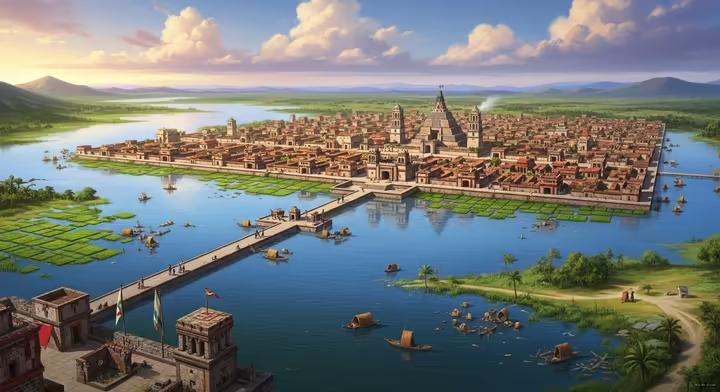
Under the ruler Montezuma II, about 7,000 tons of maize and 4,000 tons of beans flowed into the capital as tribute each year. This was even more impressive because of the tough environment. The Valley of Mexico is over 7,000 feet above sea level, with swamps, steep slopes, and the constant threat of floods, frost, and drought.
The Aztecs met these challenges by re-engineering their world. They built huge dikes, canals, and aqueducts to manage water and reclaim land for agriculture.
Working the Land
The Valley of Mexico was once a land of five shallow, connected lakes. The largest, Lake Texcoco, was salty, while the lakes to the south (Xochimilco and Chalco) were freshwater. This geography presented both big problems and big opportunities for Aztec agriculture.
Agriculture here was tough. The main lake was too salty for crops, floods were common, and so were droughts. Frost could kill plants in the high-altitude air, and good, flat farmland was hard to find.
But the valley also had its perks. The lakes offered endless fresh water (if you could control it), easy transportation by canoe, and plenty of fish and birds. Best of all, the mud at the bottom of the lakes was incredibly fertile fertilizer.
Engineering the Landscape
The Aztecs transformed their difficult environment into a food-producing powerhouse. Their success in agriculture came from smart land reclamation, water management, and planting techniques.
Chinampas, The 'Floating Gardens'
The chinampa system was the jewel of Aztec agriculture. These weren't really floating- they were man-made islands built in the shallow freshwater lakes. Workers drove stakes into the lakebed, wove a fence between them, and filled the rectangle with layers of mud and plants.

Willow trees were planted along the edges to hold everything together with their roots. The canals between the plots provided constant water to the crops and a handy way to travel by canoe. This design was so effective that farmers could get between two and seven harvests a year.
The chinampas covered about 23,000 acres and supplied a huge amount of food for the capital. It was a self-renewing system, as farmers constantly scooped nutrient-rich mud from the canals back onto the gardens.
Terrace Agriculture
To farm the hilly areas, the Aztecs built terraces. This created flat planting surfaces on steep slopes, which stopped soil from washing away and helped hold water.
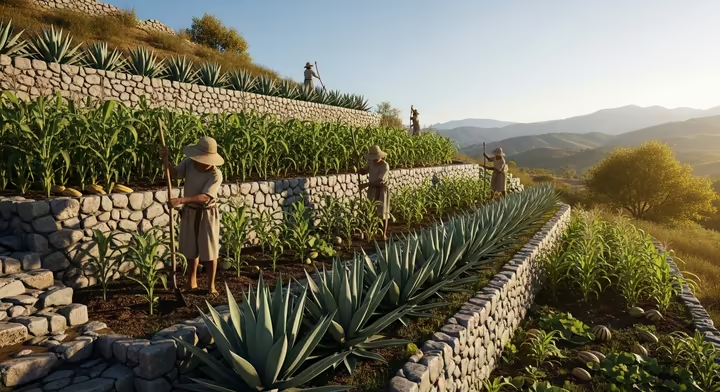
On gentle slopes, they used rows of maguey (agave) plants to hold the soil in place. On steeper hills, they built stone walls. This let them expand agriculture into lands that were otherwise too difficult to cultivate.
Water Masters
The Aztecs were experts at managing water. They built huge networks of canals to irrigate fields and aqueducts to bring fresh drinking water into the capital city. The famous Chapultepec aqueduct even had two pipes so one could be cleaned while the other kept working.
Their biggest project was the Nezahualcoyotl Dike, a 10-mile-long wall built across the lake. It protected the city from floods and separated the salty water of Lake Texcoco from the freshwater needed for the chinampas.
The Three Sisters
The Aztecs perfected the art of polyculture- growing multiple crops together. The best example is the "Three Sisters": maize, beans, and squash.
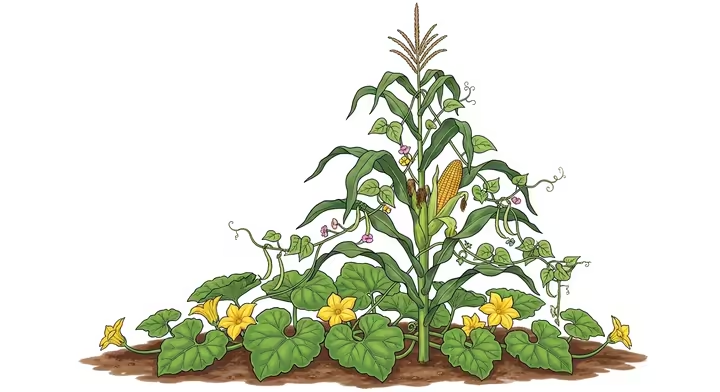
Each plant helped the others. The tall maize stalk gave the bean vines something to climb. The beans put nitrogen back into the soil, which fed the maize. The big, shady leaves of the squash plant kept the soil moist and prevented weeds from growing.
This system used land efficiently and produced a balanced harvest. Together, the three crops provided a nearly complete diet of carbs, protein, and vitamins.
Other Farming Methods
Beyond these big systems, the Aztecs also used other techniques. They practiced rain-fed farming on hillsides where irrigation wasn't possible. Most families also had small household gardens where they grew chili peppers, tomatoes, herbs, and fruit to add variety to their meals.
To keep the soil rich, they were expert recyclers. They constantly dredged fertile mud from the canals for the chinampas. They also had an organized system to collect human waste ("night soil") from cities to use as a powerful fertilizer, which kept the city clean and the farms productive.
The Empire's Pantry
Aztec agriculture involved a wide range of crops using simple but effective tools. They relied entirely on human labor to power their agricultural system and feed their empire.
Staples and Delicacies
Maize (corn) was king. The Aztecs ate it in everything from tortillas to a porridge called atole. Their key food technology was nixtamalization, a process that unlocked more nutrients in the maize and made it healthier.
Beans and squash were the other two "Three Sisters," providing protein and vitamins. Amaranth and chia were also important staples, packed with nutrients and energy.
Other crops included chili peppers, tomatoes, and avocados. The maguey (agave) plant was a super-tool, providing fibers for rope, thorns for needles, and a sap for making the alcoholic drink pulque. Luxury goods like cacao (for chocolate) and cotton were often grown in warmer lands and demanded as tribute... cacao beans were even used as money!
Aztec Tools
Aztec farming was done by hand with simple tools, since they had no plows or large farm animals. Their most important tool was the uictli (or coa ), a wooden digging stick with a fire-hardened tip.
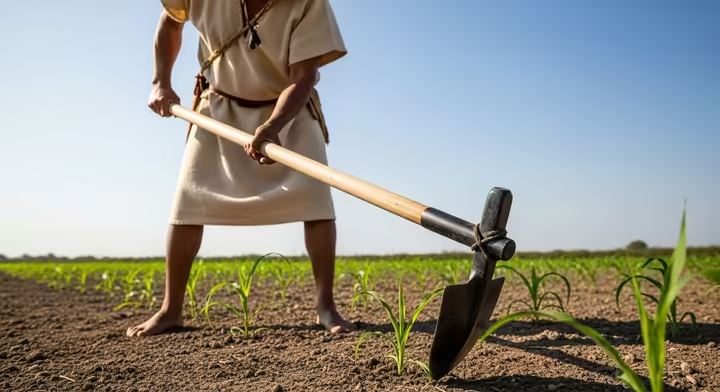
Some versions had a sharpened, flat blade or a foot-rest to help break up tough soil. This simple stick was used for everything from building massive chinampas to planting tiny seeds.
Storing the Harvest
To survive year-round and guard against bad harvests, the Aztecs stored grain in special granaries called cuezcomatl . These were often large, vase-shaped containers made of clay or adobe with a thatched roof to keep food dry and safe from pests. Many were built on platforms to keep rodents out.
A Sacred Harvest
For the Aztecs, agriculture was a sacred duty, tied directly to their religion. The success of the harvest was a gift from the gods, who needed to be honored with rituals and offerings to keep them happy. The 365-day solar calendar set the schedule for both planting and religious festivals.
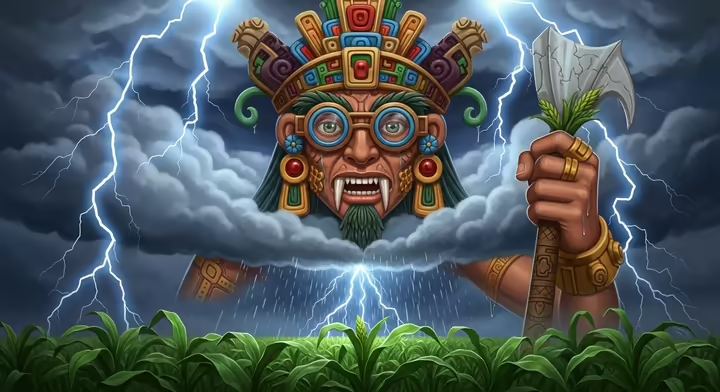
Several gods were tied to farming. Tlaloc was the powerful god of rain, who could bring life or destruction. Chicomecōātl and Centeōtl were both deities of maize, the most sacred crop, while Xilonen was the goddess of young, tender corn.
Xipe Totec, "Our Lord the Flayed One," was a god of spring and rebirth whose festival symbolized the earth growing a new "skin" of vegetation. Even the maguey plant had its own goddess, Mayahuel. These beliefs showed that the Aztecs saw farming as a partnership with the gods, who had to be paid back to keep the universe in balance.
The Social and Economic Engine
Aztec agricultural productivity depended on a well-organized society that managed land, labor, and food distribution.
Land and Labor
At the local level, society was organized into the calpulli , a group like a clan or neighborhood. The calpulli owned land as a group and gave out plots to member families. A family could farm their plot for generations, but if they let it go unused, it was given to someone else.
This system made sure everyone had access to land. These common families did most of the farm work, both on their own plots and on lands owned by nobles and temples. The state could also call on the calpulli to provide labor for big projects, like building dikes and aqueducts.
Tribute and Trade
The Aztec economy ran on tribute and trade. Conquered cities were forced to send huge amounts of food and goods like maize, beans, and cotton to the capital. This tribute fed the city's rulers, priests, and warriors.
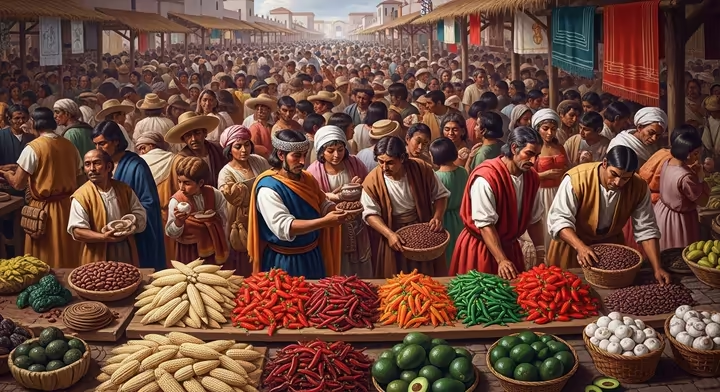
Alongside tribute was a huge network of markets. The biggest, at Tlatelolco, could attract 60,000 people a day. Here, people traded their extra produce for goods from all over the empire. While much of it was barter, cacao beans and cotton cloth were used as a form of money.
Feeding a Huge Population
The Aztec agricultural system fed one of the largest urban populations in the world before the industrial age. The capital city alone was home to up to 300,000 people.
The chinampa system was the key to this success. It's estimated that the chinampas around the capital alone could have fed over 220,000 people. It was the combination of all their strategies, chinampas, terraces, irrigation, and tribute, that created the food surplus needed to run an empire.
Aztec vs. Maya Farming
The Aztecs weren't the only farming champs in Mesoamerica. The Maya also built their society on maize, beans, and squash. Both civilizations farmed without animals or metal plows, relying on human power and simple digging sticks.
But their agricultural methods were different because their homes were different. The Aztecs lived in a high-altitude valley of lakes, so they perfected chinampas and massive dikes to control water. The Maya lived in tropical rainforests, so they used slash-and-burn (milpa) farming, tended to forest gardens, and built raised fields in swampy areas.
The Aztecs focused on controlling and managing the water in their valley. The Maya focused on managing water in wetlands and storing it in reservoirs for the dry season. Each civilization brilliantly adapted to its own unique environment.
The Conquest and After
The arrival of the Spanish in the 16th century was a disaster for the Aztec civilization and its agricultural systems. The conquest brought disease, land theft, and new economic priorities that shattered the old ways of life.
Collapse from Disease
The biggest blow came from diseases like smallpox and measles. The Indigenous peoples had no immunity, and the epidemics were devastating. A smallpox outbreak in 1520 may have killed nearly half the population of the capital city, crippling the empire's ability to resist the Spanish.
With too few people to maintain them, the complex farming systems fell apart. This led to a huge drop in food production and widespread famine.
Colonial Changes
The Spanish took over the land and introduced new crops like wheat and animals like cattle, sheep, and pigs. These animals damaged the environment through overgrazing, leading to soil erosion on the ancient terraces.
Worst of all, the Spanish didn't understand the delicate water balance the Aztecs had created. They started draining the great lakes to create more pasture land. This destroyed countless chinampas forever and changed the landscape of the valley permanently.
Still, some Indigenous farming knowledge survived. Chinampa farming continued on a smaller scale in places like Xochimilco, and maize and beans remained the core foods for the people.
Aztec Legacy
The agricultural systems of the Aztecs left a lasting mark on the land and on the world. Their legacy is visible in ancient ruins and in the food we eat today.
Clues from the Past
Archaeologists have pieced together the story of Aztec farming from many clues. The remains of chinampas can still be seen (and even farmed) today in Xochimilco. Stone terraces still line hillsides, and the remnants of old canals mark the landscape.
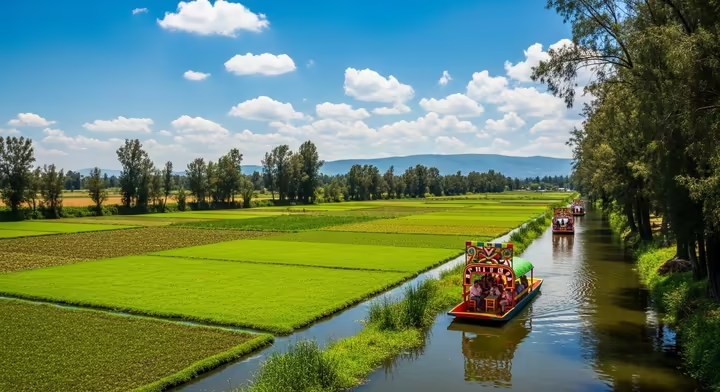
Preserved seeds and pollen tell us what the Aztecs were growing. And historical records, like Aztec drawings (codices) and Spanish accounts, provide written details about their amazing farming world.
A Lasting Harvest
The Aztec legacy is on dinner plates around the globe. They, along with other Mesoamerican peoples, first cultivated crops we now all eat, including maize, beans, tomatoes, avocados, and chocolate.
The chinampa system is now seen as a brilliant model of sustainable agriculture. Its methods of recycling nutrients, saving water, and producing a lot of food with few outside resources offer lessons for modern agriculture. The wisdom of the Aztecs can still inspire us to build better, more resilient food systems for the future.
The Pulse of a Civilization
Aztec agriculture was the foundation of their empire. By engineering their world, they turned a challenging landscape into a fertile one, allowing their massive capital city to thrive. Their system of chinampas, terraces, and canals was a marvel of ingenuity.
This agricultural powerhouse was tied to every part of Aztec life, from their economy and social structure to their religion. Though the Spanish conquest brought terrible disruption, the legacy of Aztec farming lives on. It survives in the foods they gave the world and in the wisdom of their sustainable practices.